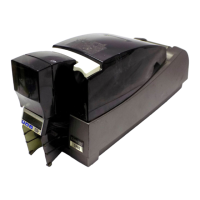CP60 and CP60 Plus Service Manual 2-35
Reader to Card Communication
The reader communicates with the card by sending an amplitude modulated
signal at 13.56 MHz. The modulation variant depends on the class of card. A
Type-A card uses 100% Amplitude Shift Keying (ASK100%). A Type-B card uses
ASK10% modulation. These two variants are shown in the graphics above.
The benefit of ASK100 is that it is more immune to noise and errors because there
is a strong difference in amplitude at bit transitions. The drawback to this is that
the card doesn’t receive power during the low cycle of the modulation. The card
doesn’t turn off during these times, but the effect is that less overall (average)
power is being transmitted to the card.
ASK10 provides more power to the card because the modulated signal remains
within 10% of the maximum amplitude. The tradeoff is that the difference
between high and low amplitudes is minimal. This can lead to slightly more data
transmission errors.

